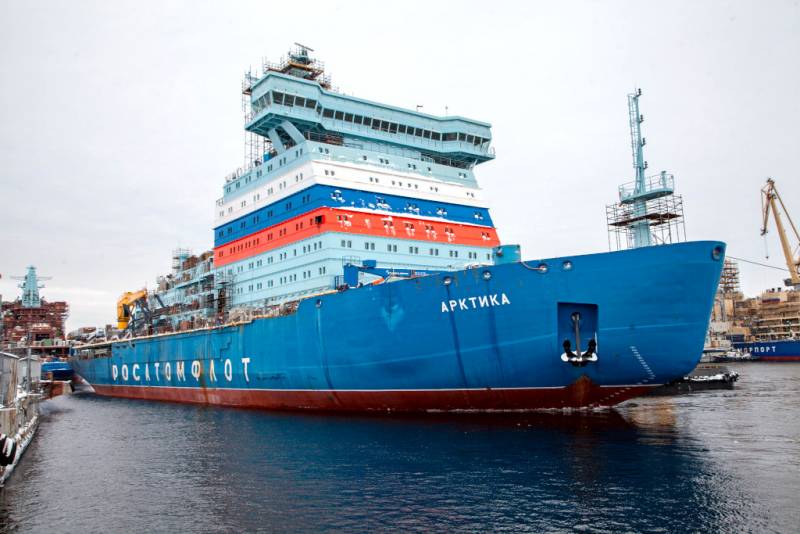Arctic "Ural": what are capable of new Russian icebreakers
The day before, an important event took place in St. Petersburg. The third icebreaker of project 22220, called the Urals, was launched. In total, there will be five ships in the series, and the first three (Arctic, Siberia, and Ural) cost the budget almost two billion dollars. However, this is the case when it is safe to say that the money was not put to the wind.
Since Soviet times, our country has the largest icebreaking fleet in the world. It has survived even in the "dashing nineties" and provides Russia with free access to the Arctic. Today, the strategic importance of this region has increased dramatically. The shortest distances pass through the Arctic to launch intercontinental ballistic missiles, giant reserves of hydrocarbons and other minerals have been discovered on its shelf, and melting ice opens up prospects for the Northern Sea Route (NSR) to become a real competitor to the Suez Canal. In addition to the “northern delivery,” icebreakers are needed for the reliable export of hydrocarbons from Arctic fields.
However, time goes by and does not spare anyone. Of the Soviet icebreakers of the old Arctic series, only two are on track, the remaining four are awaiting disposal. Russia slowed down a little more, and there would be big problems with free navigation along the NSR. Fortunately, an advanced program for the construction of a modern icebreaking fleet is being successfully implemented in our country.
Project 22220, to which Ural belongs, has incorporated many technical innovations. These icebreakers are the so-called double-draft. If earlier two ships, powerful icebreakers of the old Arctic project and with less draft of the Taimyr project, were required for delivery to the mouths of the northern rivers, now one project 22220 icebreaker is enough to change the level of its draft.
In addition, the new icebreakers are equipped with modern reactors that provide greater gross power. The service life of power plants is designed for 40 years with one overhaul, and their recharging will be carried out no more than once every 10-12 years. At the same time, ice penetration increased by 15%. Due to automation, the crew of the ship was halved.
It is interesting how the actual operating experience of the NSR affects the operation of the shipyard. To increase the speed of the pilotage of the Christophe de Margerie ice class vessels, the remaining two icebreakers of Project 22220 will be 5 meters wider than the first three already built. But that is not all. Next year, the construction of a series of icebreakers of the Leader project (LK-110Ya), which generally have no analogues in the world, will begin at the seaside shipyard Zvezda. Their power will be enough even for navigation along the NSR in the winter, which today is beyond the power of anyone.
Since Soviet times, our country has the largest icebreaking fleet in the world. It has survived even in the "dashing nineties" and provides Russia with free access to the Arctic. Today, the strategic importance of this region has increased dramatically. The shortest distances pass through the Arctic to launch intercontinental ballistic missiles, giant reserves of hydrocarbons and other minerals have been discovered on its shelf, and melting ice opens up prospects for the Northern Sea Route (NSR) to become a real competitor to the Suez Canal. In addition to the “northern delivery,” icebreakers are needed for the reliable export of hydrocarbons from Arctic fields.
However, time goes by and does not spare anyone. Of the Soviet icebreakers of the old Arctic series, only two are on track, the remaining four are awaiting disposal. Russia slowed down a little more, and there would be big problems with free navigation along the NSR. Fortunately, an advanced program for the construction of a modern icebreaking fleet is being successfully implemented in our country.
Project 22220, to which Ural belongs, has incorporated many technical innovations. These icebreakers are the so-called double-draft. If earlier two ships, powerful icebreakers of the old Arctic project and with less draft of the Taimyr project, were required for delivery to the mouths of the northern rivers, now one project 22220 icebreaker is enough to change the level of its draft.
In addition, the new icebreakers are equipped with modern reactors that provide greater gross power. The service life of power plants is designed for 40 years with one overhaul, and their recharging will be carried out no more than once every 10-12 years. At the same time, ice penetration increased by 15%. Due to automation, the crew of the ship was halved.
It is interesting how the actual operating experience of the NSR affects the operation of the shipyard. To increase the speed of the pilotage of the Christophe de Margerie ice class vessels, the remaining two icebreakers of Project 22220 will be 5 meters wider than the first three already built. But that is not all. Next year, the construction of a series of icebreakers of the Leader project (LK-110Ya), which generally have no analogues in the world, will begin at the seaside shipyard Zvezda. Their power will be enough even for navigation along the NSR in the winter, which today is beyond the power of anyone.
- Sergey Marzhetsky
- http://shipsupply.ru

Information